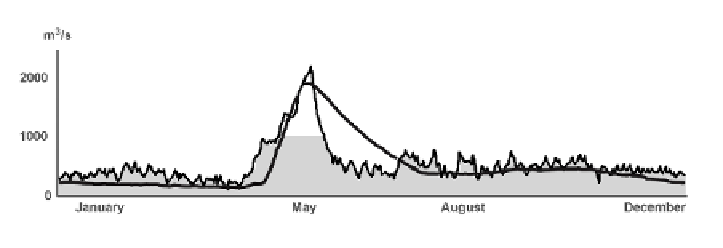Environmental Engineering Reference
In-Depth Information
Fig. 19.3.
River discharge (in cubic metres per second, m3/s) from one of the hydropower
stations on the Kemi River's main channel in 2007. The black line indicates the actual dis-
charge, the shaded area under the curve represents the amount of water that was used for
electricity generation. The white area between black line and shaded area stands for the
amount of water that was spilled past the turbines during the spring flood, when discharge
exceeded the turbines capacity of 1000 m3/s. The grey line indicates the discharge that
would occur at the locality without storing flood water in the reservoirs and daily regulating
the flow (based on Kemijoki Group 2008, p. 10)
The large-scale harnessing of the Kemi River for hydroelectricity began after the
Second World War, when Finland executed major infrastructure projects through-
out the country and invested into the economic development of the province of
Lapland, which had suffered severely during the war. Hydroelectricity was a ma-
jor component of the development strategy, along with road construction and the
settlement of small farms in the region. After a private company had built two
power stations in the watershed, it ran out of money, which prompted the state to
set up an institution that was solely meant to develop hydroelectricity on the Kemi
River. This state-owned company built power plants along the main course of the
river from the early 1950s and constructed large reservoirs during the 1960s. In
the 1980s and 90s, the harnessing of water power was extended into a major tribu-
tary of the river. Plans to build a further large reservoir on the headwaters of the
river were debated for decades until they were ruled out of order by the Finnish
Supreme Administrative Court in 2002. Another large tributary had already been
placed under natural protection in 1983, banning all constructions for hydroelec-
tricity generation. Under the present legal and technical conditions, there is only a
single location on the Kemi River that seems appropriate for the construction of a
further power plant. The respective plans exist and hydroelectricity engineers
point out that this power station will complete the infrastructure to regulate the en-
tire main course of the river in one 'chain'.
19.3 Salmon Weirs on the Kemi River
When the first hydroelectric dam on the river was finished in 1948, its impacts on
the ecology of the river and on the livelihoods of the inhabitants of its banks were

Search WWH ::

Custom Search